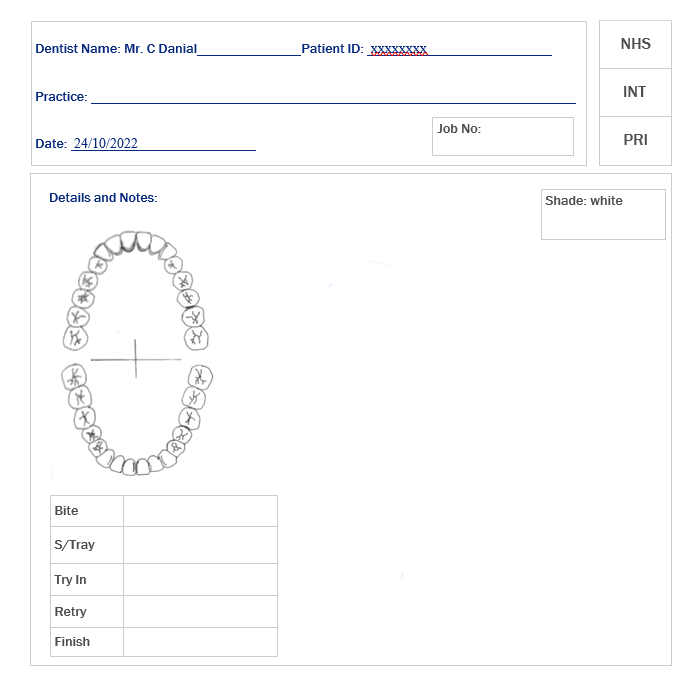DNI 9 Fixed & Removable Prosthetics Support & Impression Materials
Introduction: Prosthetic Rehabilitation Case Study on Immediate Dentures
This workbook accompanies the Fixed and removable prosthesis session delivered by your tutor it will consist of a series of questions and require you to research information.
You will use varying methods to enable you to complete these questions. All can be completed using either written, typed, or audio answers to demonstrate your knowledge and understanding of how you support your service users within your setting. Discuss with your tutor and decide your preferred method.
This unit has four learning outcomes
The learner will:
- Be able to support the individual and operator with fixed and removable prosthetic procedures.
- Be able to select and prepare impression materials for fixed and removable prostheses.
- Be able to prepare equipment, instruments, and materials for fixed prostheses.
- Be able to prepare equipment, instruments, and materials for removable prostheses and orthodontic appliances.
Evidence requirements
Minimum requirement of one observation. Supporting evidence of learner understanding must be completed and provided to support performance evidence. Simulation is allowed for this unit.
Unit DNI 9: Provide support during the provision of fixed and removable prostheses (T/618/4916)
This unit focuses on the knowledge and skills required to support the individual and operator during the provision of fixed and removable prostheses.
Guided learning hours for unit DNI 9 is 35 hours.
This unit is mandatory and is not graded all criteria must be met before completion of this unit.
This unit will also have clinical observations by an assessor.
Relationship to GDC Learning Outcomes:
1.7.3, 1.7.4, 1.8.2, 1.11.1, 1.11.2, 1.11.3, 3.2
Relationship to Dental Standard Knowledge, Skills, and Behaviours
K23: Know and understand how to prepare materials in line with manufacturers recommendations
K24: Know and understand Health and safety legislation relating to dental materials and other medication
K25: Know and understand the importance of maintaining accurate and current patient records by legal and regulatory requirements

Task 1
(learning outcome 1, assessment criteria 1.1, 1.2, 1.3, 1.4, 1.5, and 1.6)
- What would the aftercare advice be for TWO of the following individuals for the care of new removable prostheses and immediate dentures? Include maintenance, and what to expect when getting used to new dentures.
- Adults
- Children and young people
- Older people
- Those with additional needs
|
1. Adults
|
The patient needs to ensure to wear dentures for a minimum of three days and nights, as there is a high risk of swollen tissues if the dentures are extracted. Besides, the patients need to consume semi-solid or liquid food for at least a week (Allen, 2019). On the other hand, brushing the teeth can be avoided at this stage and simple mouthwash should be sufficient for the patient to remove bacteria and minimize the sign of infection. |
|
2. Children and young people
|
In the case of children and young people, it should be kept in consideration that the patient should not bite the tongue or cheeks while installing removable prostheses and immediate dentures (Farrow-Hamblen, 2022). Temperature check at regular intervals is required to ensure the patient has no sign of infection. Besides, oral hygiene maintenance is required for them to reduce the chance of infection. |
2. Explain how it would differ for EACH of the different individuals.
|
Adults |
In adults care for new removable prostheses and immediate dentures should be done systematically. The individuals should not open prostheses or immediate dentures until three days after installation. Besides, regular mouthwash is required to minimize the probability of infection in the oral cavity. Besides, after a period, regular maintenance of oral hygiene is required. |
|
Children and young people |
In terms of caring for prostheses and immediate dentures for young patients, overextensions along the borders are checked and minimum manipulation is ensured to maintain safety (Tanaka et al., 2022). While insertion, proper maintenance of hygiene is required and regular temperature checking is required to ensure there is no sign of oral infection. |
|
Older people |
In terms of caring for prostheses and immediate dentures for elders, some steps are needed to be incorporated. Regular mouthwash is required to ensure hygiene maintenance and reduce the probability of swelling. Besides, semi-solid or liquid foods should be taken as a diet for an extended period to ensure proper care. After a week, the centric relation is re-evaluated and post-insertion instructions are reinforced. |
|
Those with additional needs |
To maintain oral hygiene for individuals with additional needs, extra care needs to be introduced by dentists or peers, as they might be incapable of considering oral care by themselves. For the individuals, relining needs to be replaced periodically and centric relation should be maintained by clinical mounting (Yeung et al., 2020). |
3. Outline the procedure for supporting the individual patient and operator with removable prosthetic procedures. Include the following stages:
- Selecting individuals’ records and charts for the procedure
- Providing necessary equipment for the taking of shades and the dental nurse’s role during the procedure
- Providing the necessary equipment and materials for occlusal registration and the dental nurse’s role during the procedure
- How should the dental nurse assist the operator with protecting and retracting soft tissues during treatment?
|
As per the medical records of individuals, special care is needed to be taken. Nurses and dentists should arrange equipment for outlining dentures, which are locating pins, clasps, undercut gauges, etc. Then an oral impression is taken with precautions and as per soft tissue and hard tissue lining, prostheses are designed. As per medical records and history, specific tools are utilized. Registered nurses tend to provide support to the patients for proceeding with the procedure. |
Task 2
(learning outcome 2, assessment criteria 2.1, 2.2, 2.3, 2.4, 2.5, 2.6, 2.7, and 2.8)
1. Outline the procedure for selecting and preparing impression materials for fixed and removable prostheses. Include the following stages:
- Selecting impression materials and trays for fixed and removable prostheses
- How to prepare the impression material (both alginate and putty) to the required consistency
- How to ensure that the handling and setting time is relative to the material (both alginate and putty) and ambient temperature
- The technique used for loading impression materials onto the impression tray
- How to monitor the individual (adults, children and young people, older adults, and those with additional needs) when impressions are in the mouth
- Outline the procedure for the disinfection and storage of alginate and putty impressions
- Complete a laboratory docket (using a made-up patient) with the necessary information for a fixed and removable prosthesis. How would you ensure it is attached to the laboratory work?
|
In terms of selecting and preparing impression materials for fixed and removable prostheses, some steps are needed to be followed by experts. At the very first stage, the dental profile of the individual is checked and the shape of the dental formation needs to be noted down. After that, the proper impression material is chosen for preparing fixed or removable prostheses. Dental impression materials are used to copy oral tissues in terms of creating a dental impression (Ercoli and Caton, 2018). Thus, the impression compound may be used as an impression material. There are two basic types of this impression material: type 1 and type 2. Type 1 is considered the fusing impression compound, which is available in the form of a sheet and stick. On the other hand, type 2 is considered a tray compound for making the impression tray (Gupta and Brizuela, 2022). In terms of developing the compound, the components, such as rosin, resin, carnauba wax, stearic acid, talc, and coloring agents are required. Among those materials, stearic acid tends to provide plasticity to the impression material and talc tends to provide hardness. All the prior-mentioned components are mixed in a 6:6:2:1:15 ratio to maintain the consistency of the impression material. The material is thermoplastic and it is only set by the physical reaction. In terms of preparing the material water bath, burner, gauge pipe, scalpel, and blades are required. Type 1 sheet impression compound is softened in a water bath and then kept at 55-60°C (Gupta and Brizuela, 2022). The material is placed on mucosa and it tends to impress mucosa under compression. The impressions are then correlated with another impression made in another impression tray on the primary cast. Then type 2 impressions are used for wash impressions. The process takes a significant time until a proper impression is made. Regarding monitoring the individuals, oral hygiene needs to be followed and a well-planned and coordinated dental nurse, dentist, and technician effort is required. However, the impression should be disinfected in terms of preventing cross-infection. The impression needs to be implemented after washing residues of saliva and blood. A specific disinfectant is applied with hydrocolloids and polyether for their hydrophilic advantages. Besides, elastomers are used as liners in abused tissues. On the other hand, digital density technology can be introduced to reduce the risk of contamination. After fitting the fixed or removable prostheses, manipulation can be done to avoid adversities. Special care is needed to be incorporated for children and individuals with special abilities. Laboratory docket is considered to be a part of the clinical records of patients for treatment and prosthesis installation. The cluster of information needs to be introduced in the laboratory work to ensure the right way to develop the prostheses. This laboratory docket is helpful to provide information about the patient. Based on dental alignment, prostheses are designed. The prostheses should not be used in the undercut areas and the impression has to be washed off saliva and should be disinfected with 2% glutaraldehyde (Tribst et al., 2020). This laboratory docket is ensured to be attached for prosthesis development and manipulation.
Figure 1: Laboratory docket |
Task 3
(learning outcome 3, assessment criteria 3.1, 3.2, 3.3, and 3.4)
1. Outline the following procedures for the preparation of equipment, instruments, and materials for fixed prostheses:
2. Include the following stages:
- Selecting the equipment, materials, and instruments (explain what the instruments are and what they are used for)
- What is the way to prepare adhesive material for the fixing of a fixed prosthesis?
- When would the adhesive material be mixed?
- How should it be mixed?
- What consistency should it be?
|
Preparation of a temporary/permanent crown and bridge |
Mainly with two sittings the crown or bridges were usually taken in the first sitting the teeth are processed and the precision of the digital scan is taken. This is mainly depending on the type of procedures an individual has had, as prep for the crown and may need to make a temporary. Primary work is counting impressions. Most dentists applied the paste or materials like putty. Ten retractions are placed within the tooth and the surrounding gum tissues to get while tooth impression (Kamalapurkar, 2022). The bite impressions were also taken by the dentists. This production required near about two weeks. |
|
Fitting of a temporary/permanent crown and bridge |
If a temporary crown was placed then it was not placed permanently on teeth. dentists placed the crown over the tooth with the aid of adhesives which can also be removed easily and that’s why this is not as strong as the permanent implants, at the second appointment or until the arrangements of permanent crowns those placed on the teeth (Casián-Adem, et al. 2021). The damaged natural crown of the tooth was detected the damaged teeth were shaped and a replacement crown was prepared then, temporary/permanent crowns were placed on the shaped tooth with the aid of adhesives. |
|
Adjustment of temporary/permanent crown and bridge. |
Pain, sensitivity, problems during biting, and observation of dark lines on the crown can be caused due to the ill-fitting of the crown. Root canal infections, decay, natural dental crown damage, and discoloration of teeth are some of the causes that can introduce the requirement for permanent/temporary crowns (Pernet, 2021). Those crowns are mainly made with resin, metal, and porcelain. Those are mainly caps that are placed on the damaged tooth. |
3. What instruments should be provided for the trimming, cleaning, and checking of the final adjustment of a fixed prosthesis?
|
4. What aftercare advice should be given for FOUR of the following fixed prostheses?
- Crowns
- Inlays
- Veneers
- Permanent bridges
- Adhesive bridges
- Temporary bridges
- Temporary crowns
- Implants
|
1. Crowns: Though the crown is not decayed the edge of the tooth where it is placed can decay. That’s why after getting a crown it needs proper care as regular brushing teeth. In this case, fluoride toothpaste can be applied (Valdivia et al, 2018). |
|
2. Permanent bridges: After 24 hours of the placement of the permanent bridge, restrictions are needed to maintain the consumption of hard, sticky, chewy food only liquid food is allowed (Haikal et al. 2020). There is a chance of gum sore after three days of placement which can be under control by rinsing the teeth with warm water a minimum of 3 times every day which helps to reduce the swelling and pain. |
|
3. Inlays: In the post-procedure of Inlays an individual needs to avoid the consumption of extreme temperature drinks and foods and also hard and sticky food. It needs to give the mouth a gentle rest with simple and nutritious food. It can feel like numbness till two days after the process. That’s why it needs to wash the teeth properly a minimum of two times a day (Coulibaly, et al. 2022). The application of mouthwash can help to reduce bacteria. |
|
4. Veneers: Application of mouthwash and visit to the dentist at regular intervals. Avoid hard food dark liquids (alcoholic beverages) and tobacco. |
Task 4
(learning outcome 4, assessment criteria 4.1, 4.2, and 4.3)
1. For the following removable prostheses:
|
Type of denture |
Outline each stage |
outline the procedure for the preparation of equipment, instruments, and materials for removable prostheses |
list instruments, equipment and materials for each stage (explain what each one is used for). |
|
Metal-partial denture |
Dental examination, making dentures, fitting the dentures |
In the very first stage, impressions of the upper and lower arches are taken and then mouth preparation is done. Then, final impressions are taken. |
Locating pin for making end of clasp with a vertical line, ney undercut gauge for measuring undercut, wax clasp step on the area of the tooth. |
|
Acrylic- full denture |
Dental examination, denture preparation, denture fitting |
A dental examination is done at the first stage and an impression is taken. As per fitting, the acrylic denture is set and those dentures are set in patients. |
Locating pin for making end of clasp with a vertical line, ney undercut gauge for measuring undercut, wax clasp step on the area of the tooth. |
|
Immediate denture |
Dental examination, right size, and shape choosing, denture fitting |
In this case, dental health is checked and as per proper size, digital impressions are done and those are fitted. |
Digital impression scanner for scanning oral cavity, new undercut gauge for measuring undercut |
2. Explain the range of orthodontic treatments available for individuals with malocclusions.
|
Removable devices: This includes retainers and headgear, which tend to align the teeth in position so that the jawbone can grow properly. Fixed multibracket braces: In this case, dental brackets are attached to each tooth and those are connected with wire to bring teeth in proper alignment (Alcón et al., 2021). Invisalign: This is a transparent dental brace, which tends to align dental lines. |
3. Explain the instruments, equipment, and materials that are used in the following stages of fixed and removable orthodontic treatments:
|
Fitting Band-removing pliers are used for removing bands. Bracket positioning instruments are used for bracket positioning. Arch-forming instruments are used for arch contouring. |
|
Monitoring The dental mirror is used for oral cavity visualization. |
|
Adjusting Mathieu pliers can be used for locking and unlocking mechanisms for elastomeric ligatures. Band pusher is used for positioning orthodontic bands on teeth |
4. Research, and explain your understanding of, digital impression-taking. Include the positives and negatives of this impression method.
|
Digital impressions are cutting-edge technology that tends to allow dentists to create a computer-generated replica of soft and hard tissues in the mouth (Cappare et al., 2019). With this digital technology, Clear and highly accurate oral impressions can be developed. Thus, this technology is easier to use for more comfortable procedures. Advantages of digital impressions: ● Significantly low treatment time. ● It is appropriate for patients with gag reflexes. ● Data of digital impressions can be stored easily. ● Digital technology can make accurate impressions. Disadvantages of digital impressions ● High cost of impression generation. ● Full arch impression can be less accurate. ● The size of the intraoral scanner is huge, which is challenging to move. |
Learner declaration of authenticity: DNI 9
I declare that the work presented for this unit/task is entirely my work.
Learner signature: Date:
For an e-portfolio, a signature is not required, providing the learner has a personalized and secure login
Reflective Account
Think about what you have learned during this unit. How has your knowledge improved and how have you applied this to your working practice? Please reflect below on the workbook you have completed by answering the following questions.
What have you learned or how has this reinforced what you already knew?
|
Through this evaluation stage, I have reinforced information, which I already knew. This has helped me to sharpen my knowledge and has helped with self-evaluation. |




